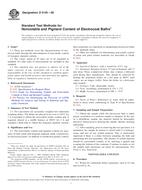1.1 Paper industry sludges are industrial by-products derived from wastewater treatment operations at plants associated with the manufacturing of paper. These sludges typically consist of clay and organic matter. They may also contain low levels of inorganic and organic contaminants and can be rich in microbes. Traditionally, paper industry sludges have been disposed in municipal solid waste landfills or solid waste monofills. However, in the interest of sustainability, applications are being developed where sludges can be used beneficially. One application is using sludge to construct hydraulic barriers (for example, for use in a landfill cap). Such applications generally require that the hydraulic conductivity of the sludge be measured.
1.2 Compacted paper industry sludges generally behave like soils and are amenable to geotechnical testing methods. However, several of their attributes require special attention during testing. Compacted industry sludges generally are highly compressible due to their organic component. Thus, their hydraulic conductivity can be more sensitive to the effective stress and hydraulic gradient applied during testing than most soils. The microbes in paper sludge can also produce gas during testing, confounding testing methods.
1.3 This guide is intended to supplement ASTM D 5084, Test Methods for Measurement of Hydraulic Conductivity of Saturated Porous Materials Using a Flexible Wall Permeameter. The purpose of the guide is to provide additional guidance on issues relevant to testing sludges using Test Methods D 5084. The guide applies to specimens compacted in the laboratory using procedures such as those described in Test Methods D 698 and D 1557 or undisturbed specimens collected from the field using procedures such as Practice D 1587 or Practice D 7015.
1.4 This standard does not purport to address all of the safety concerns, if any, associated with its use. It is the responsibility of the user of this standard to establish appropriate safety and health practices and determine the applicability of regulatory limitations prior to use. This standard contains a hazards section regarding the use of biocides (Section 10).
1.5 This guide offers an organized collection of information or a series of options and does not recommend a specific course of action. This document cannot replace education or experience and should be used in conjunction with professional judgment. Not all aspects of this guide may be applicable in all circumstances. This ASTM standard is not intended to represent or replace the standard of care by which the adequacy of a given professional service must be judged, nor should this document be applied without consideration of a projects many unique aspects. The word “Standard” in the title of this document means only that the document has been approved through the ASTM consensus process.
Product Details
- Published:
- 11/01/2011
- Number of Pages:
- 5
- File Size:
- 1 file , 110 KB
- Redline File Size:
- 2 files , 190 KB


